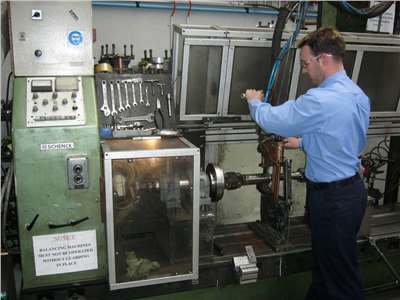
Article - What does ‘dynamic balancing’ mean?
Author - Ashley Wass Technical Services Engineer Bearing and Power Transmission
For a machine to be out of balance (unbalanced) it must have anuneven distribution of mass about its rotor’s rotating centreline. The key phrase to note is “rotating centreline,” as opposed to “geometric centreline.” The rotating centreline is defined as the axis about which the rotor would rotate if not constrained by its bearings. The geometric centreline is the physical centreline of the rotor. When the two centrelines are the same, then the rotor will be in a state of balance. When they are different, the rotor will be unbalanced.
Therefore, dynamic balancing means to reduce the uneven distribution of mass about a rotor’s rotating centreline. The effect this has on the rotor, as well as on the complete machine, is to reduce the vibration levels of the machine. When balanced, the vibration levels will be under an acceptable vibration level.
So what are the acceptable vibration levels for rotors to be considered to be in balance? International Organisation for Standardisation (ISO) publishes international standards for business, government, and society. In industry, the relevant standard for balance is ISO 1940-1:2003 Mechanical vibration -- Balance quality requirements for rotors in a constant (rigid) state --
Part 1: Specification and verification of balance tolerances. This standard gives specifications and acceptable vibration levels for rotors in a constant (rigid) state according to their machinery type and maximum service speed.
The following table is an incomplete copy of ISO 1940/1 for reference only. For all standards, purchases, and information refer to the International Organisation for Standardisation.
*there are other meanings for these words but in relation to other topics| Grade | General Examples |
| 100 |
|
| 40 |
|
| 16 |
|
| 6.3 |
|
| 2.5 |
|
| 1 |
|
| 0.4 |
|
CBC, and other dynamic balancing service providers or consultants that perform dynamic balancing, will provide this service in-situ, for example fan balancing. In-situ fan balancing is where the correction of the unbalance in the fans rotating component is done while the component is in its working environment, in other words it is performed in the field.
There are many advantages of in-situ balancing over off-site balancing. These advantages are:
- Costly and time consuming dis-assembly to remove the rotor to a balancing machine is eliminated.
- Improves product quality.
- Reduces downtime, labour, and material costs.
- Can be planned into scheduled short time outages e.g. process changes.
- Extends bearing and machine life.
- Reduces the possibility of catastrophic failures.
- Increases safety.
- Balancing is performed on the complete assembled machine and compensates for the assembly tolerances.
- The effects of temperature, pressure, distortion, and other environmental influences can be incorporated.
- The resultant vibration can be the tolerance applied to the rotor, rather than the published balance tolerances normally used in a balancing machine. This is particularly advantageous if the supporting structure is close to a resonance. The unbalance in the rotor may have to be adjusted to abnormally fine levels to minimize the resultant resonant structural vibration.
How is unbalance fixed in-situ? CBC, and most service providers or consultants, use modern instruments such as vibration analysers, data collectors, and portable balancers to provide accurate information to assist in the balancing process. The vibration level measured at the rotating speed frequency is used as an indicator of the amount of unbalance. The location is determined by measuring the phase. Phase, the relative motion of one part of a machine to another, is measured by means of a stroboscopic light or by an indicator in the instrument, triggered by a photocell.
The machine driving the component must be able to be operated and shut down multiple times to enable data about the rotor’s vibration, in relation to phase angle, to be measured, and adjustments to be made. Access to the rotor is a must. This is for weight to be added or removed, i.e. drilling holes, to reduce the uneven mass distribution around the rotating centreline. Again, in the case of fan balancing, this means drilling holes in the fan blades etc.
The following is a simplified procedure to balance a rotor as in fan balancing:
The machine is initially run and the vibration levels recorded. A trial weight is then added, or multiple weights added if there are two or more planes, and the new vibration levels are recorded. The instrumentation performs mathematical calculations by comparing the two vibration levels and phase angles and recommends where weight should be added to reduce the unbalance. Adding weight may need to be done several times in several locations, with the vibration levels being recorded each time, and the instrumentation recalculating the data to give further corrections to reduce the unbalance to within acceptable vibration levels.
In addition to providing dynamic balancing services on site, CBC also provides training and necessary components, such as balance weight kits (CBCAPO13O(A)), data collectors, and portable balancers. Rotor and fan balancing are common services provided by CBC.
References:
- http://dictionary.reference.com/browse/dynamic
- http://dictionary.reference.com/browse/balance
- www.vibrotech.co.uk/insitu-balancing#why
- Dynamic Balancing “Causes, Corrections and Consequences” By Jim Lyons, EntekIRD International, 1998
- “Balance Quality Requirements of Rigid Rotors - The Practical Application of ISO 1940/1” By IRD P/N E51267 Rev: 2 Mar 2009
- www.precisionbalancing.com.au/industrial-balancing-standards.html
- www.iso.org/iso/search.htm?qt=balance&searchSubmit=Search&sort=rel&type=simple&published=on